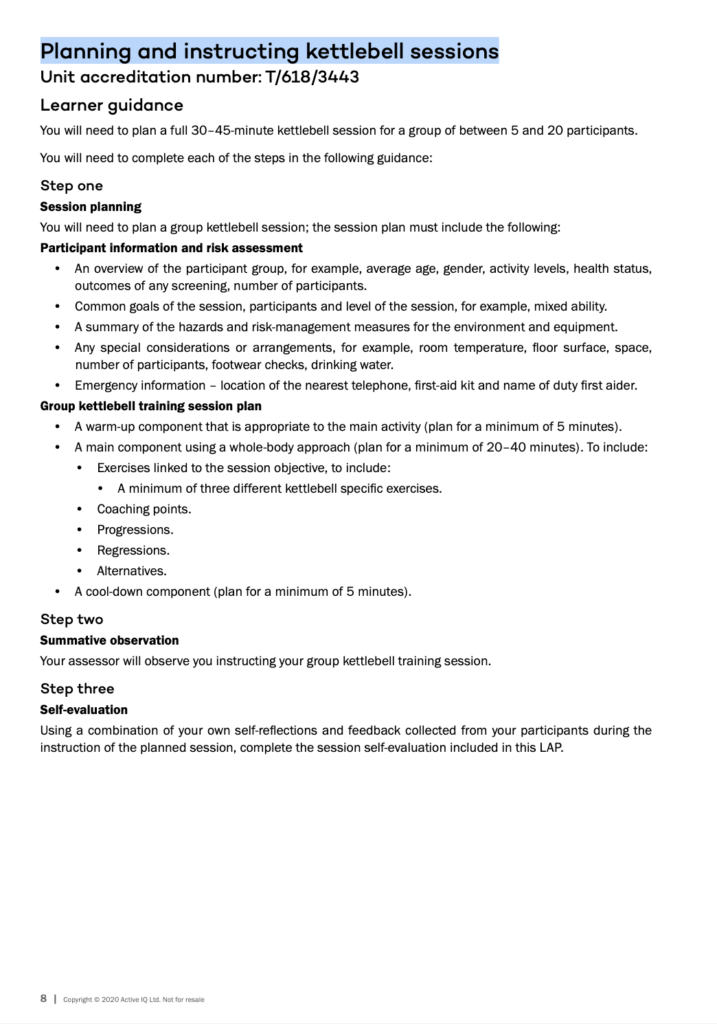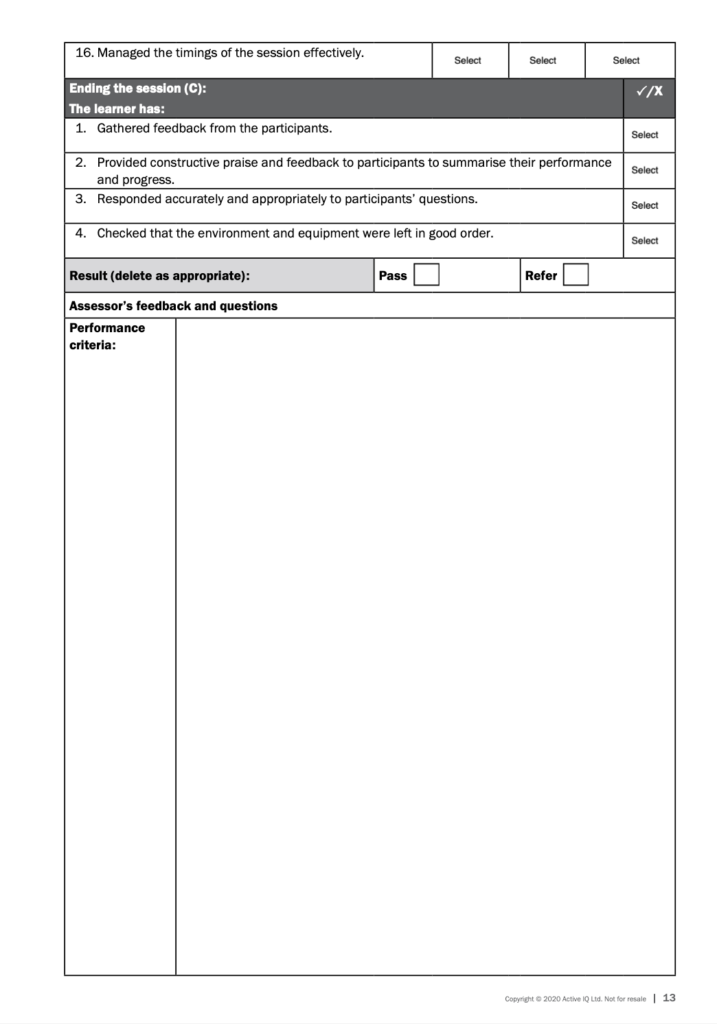Planning and instructing kettlebell sessions
Step-by-Step Guide for Kettlebell Session Planning and Risk Assessment:
- Session Planning:
-
- Location: Consider if the session will be indoors or outdoors and plan for the corresponding safety requirements.
-
- Fitness Level of Group: Gauge the fitness levels present to set the right intensity.
-
- Skill Level of Group: Assess whether participants are beginners, intermediate, or advanced.
-
- Target Group Information: Note the demographics like number, gender, and average age.
-
- Total Length of Session: Determine how the length will affect the session’s structure.
-
- Session Overview: Provide a snapshot of what the session will entail.
-
- SMART Goals: Set clear objectives following the SMART framework.
-
- Methods to Monitor Safety and Intensity: Decide on the tools and methods to be used.
-
- Equipment and Facilities Required: List all necessary items for the session.
-
- Health and Safety Checks: Plan for checks before the session begins.
-
- Identified Hazards: Identify potential risks associated with the session.
-
- Hazard Management: Outline how you will mitigate identified risks.
-
- Health Screening: State the health screening process before the session.
Below is a hypothetical example of a risk assessment

Session plan
Guidance for Kettlebell Session Planning and Risk Assessment:
Whole session:
- Summary of Risks: Identify common risks in kettlebell training, such as improper lifting technique leading to injury.
- Risk Management Strategy: Develop strategies for mitigating risks, including clear instructional signage and establishing spotters for beginners.
- Music Use: Choose music that motivates but does not distract, with breaks in music for instruction times.
- Visualisation Techniques:
- Encourage participants to visualise their muscles engaging during lifts for better technique.
- Use cooldown imagery to promote relaxation and recovery.
- Intensity Monitoring: Implement the use of fitness trackers to monitor participants’ effort and heart rate.
- Coaching Points:
- Focus on educating about proper form, pacing, and kettlebell handling to minimise risk.
- Prepare to give real-time feedback to correct form during the session.
- Participant Needs:
- Plan modifications for exercises to cater to varying fitness and skill levels.
- Ensure alternative exercises are available for those with specific restrictions.
- Space Utilisation: Ensure the training area allows for ample space around each participant to safely perform kettlebell swings and movements.
Warm-up:
- Appropriate Exercises: Include dynamic stretches and light kettlebell exercises to prepare the body for the workout.
Main Component:
- Linked to Objectives: Choose exercises that align with the goals of improving strength, endurance, and technique.
- Techniques: Teach and demonstrate the correct form for each kettlebell exercise.
- Muscle Balance: Plan exercises that work on all major muscle groups evenly.
- Intensity and Duration: Design the session to progressively build intensity and incorporate adequate rest.
Cool-down:
- Safe Cool-down: Incorporate lighter exercises and stretching to bring the heart rate down and begin recovery.
Remember to closely follow the provided marking scheme to address each point thoroughly, and ensure that all necessary safety measures and teaching techniques are incorporated into your session plan.
Hypothetical Client Example for Full Marks: Kettlebell Session
Whole session:
Summary of Risks (1 mark): Identified potential for grip loss due to sweat; ensured chalk and towels are available.
Risk Management Strategy (1 mark): Set up a regular equipment inspection routine before each session.
Music Use (1 mark): Selected rhythmic music to maintain tempo but ensured volume allows for clear instruction.
- Visualisation Techniques (2 marks):
- Crafted narratives for power sets imagining lifting in challenging outdoor environments.
- Designed a post-workout visualisation to encourage mental recovery and muscle relaxation.
- Intensity Monitoring (1 mark): Utilised wearable tech to monitor participant exertion levels in real-time.
- Coaching Points (2 marks):
- Highlighted proper form and technique to prevent injury.
- Developed motivational cues to encourage peak performance during lifts.
- Participant Needs (3 marks):
- Offered lighter kettlebells and modified movements for beginners.
- Created challenging compound movement sequences for advanced individuals.
- Provided alternative exercises for participants with specific limitations.
- Space Utilisation (1 mark): Arranged kettlebells stations to allow safe distancing and unobstructed movement.
Warm-up:
- Appropriate Exercises (4 marks):
- Began with dynamic stretching to prepare the body for movement.
- Included grip-strengthening exercises to enhance control.
- Incorporated joint mobility drills specifically for shoulders and hips.
- Initiated with low-weight kettlebell movements to establish form.
Main Component:
- Linked to Objectives (2 marks): Combined kettlebell swings, squats, and presses to improve functional strength.
- Techniques (2 marks): Demonstrated the hip hinge for swings and proper rack positions for safety and effectiveness.
- Muscle Balance (1 mark): Ensured a balanced workout targeting both the anterior and posterior chains.
- Intensity and Duration (1 mark): Planned progressive overload with intervals to challenge and build endurance.
Cool-down:
- Safe Cool-down (3 marks):
- Conducted a step-down routine reducing weight and intensity.
- Focused on static stretching for muscle groups used during the session.
- Guided participants through deep breathing to lower heart rates and promote relaxation.








